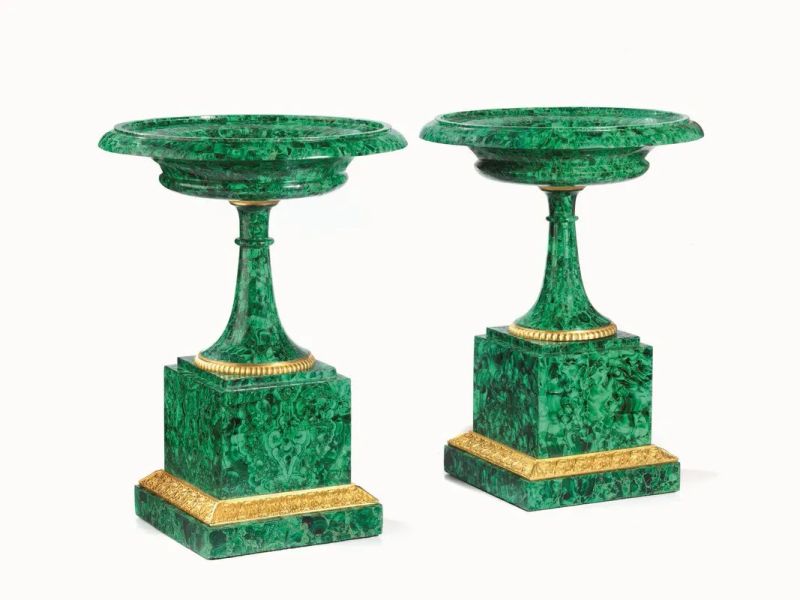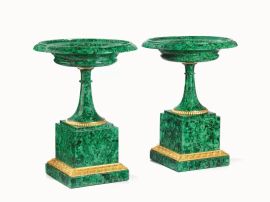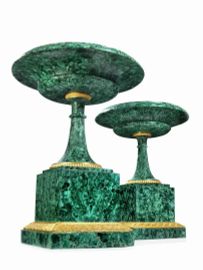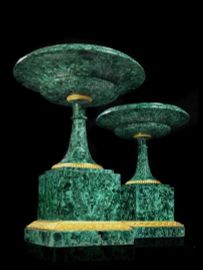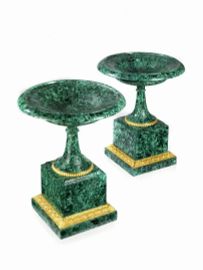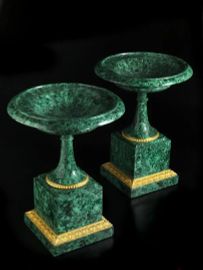Imperial Lapidary Works
PAIR OF ORNAMENTAL VASES, RUSSIA, FIRST QUARTER OF THE 19TH CENTURY
Malachite and gilded bronze; the rounded and contoured cup is melded to a turned foot which rests on a plinth-shaped base; the various parts are connected and embellished with a finely chiselled and gilded bronze framing; height 53.3 cm, diameter 41 cm, base 25x25cm
Provenienza
Collezione Bittheuser, Germania
Collezione privata
Malachite artefacts are characteristic of the rich and refined taste of early 19th century Russia. Master craftsmen worked on this material using the “Russian mosaic” technique: they cut it up into small plaques which they then melded together and polished, creating the illusion that the object was made out of a single block of material, thanks also to the subtle interplay of lines produced by the veins of the stone. These artefacts were often embellished using rich gilded bronze framings, which created wonderful effects of light and contrast.
Founded in 1725 near the summer residence of Peterhof, and thanks to the expanding quarries extracting stones needed to build both churches and magnificent palaces, the Imperial Manufacture of semi-precious stones reached its moment of highest splendour in the 19th century, to the point that its work was also displayed at both Russian and international Expositions, proving a great success.
Alongside its new workshops in Ekaterinburg and Kolivan, founded respectively near the Urals and Altai mountains so as to treat the stones closer to their locus of extraction, the Peterhof Manufacture produced many pieces throughout the 19th century, destined mostly to the Imperial court, and more rarely to private clients.
In this prestigious production, malachite became one of the Tsar’s favourite materials, and thus famous internationally, as he often brought it as a wedding or diplomatic gift to many of Europe’s rulers (fig. 1), particularly in Germany. And it is precisely from Germany that these two cups come from, having belonged to Matteo Bittheuser, who was an intimate advisor to Archduke Leopold II in Florence.
Another example of a precious gift given by the Russian rulers is constituted by the cup given by the Russian Tsar to Vittorio Emanuele II, and which is today held in the Royal Palace in Turin, as well as other objects we can admire in the Malachite Salon in the Grand Trianon in Versailles (fig. 2) or throughout other important museums worldwide.
Comparative literature
D. Ledoux-Lebard, Le Grand Trianon, Meubles et objets d’art, Paris 1975, pp. 107 e 112;
V.B. Semyonov, Malachite, Sverdlovsk 1987;
A. Gaydamark, Empire Russe, Moscou-Paris 2000, p. 85;
N. Mavrodina, The Art of Russian Stone Carvers 18th-19th Centuries, St. Petersburg 2007;
E. Kalnitskaya (a cura di), Meraviglie degli Zar. I Romanov e il Palazzo Imperiale di Peterhof, catalogo della mostra Reggia di Venaria Reale, Sale delle Arti 16 Luglio 2016 - 29 Gennaio 2017, Torino 2016, pp. 75-77 e fig. 4.

